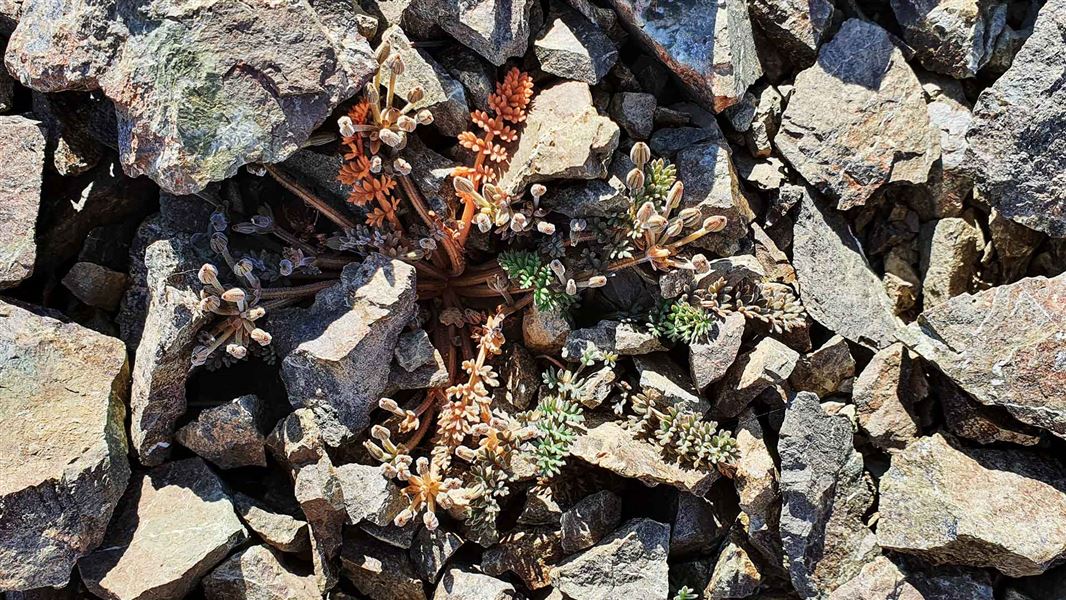Archived content: This media release was accurate on the date of publication.
Date: 02 March 2022
The discovery was made during an expedition at the end of January, when Brian was assisting Te Papa scientist Heidi Meudt in surveying for forget-me-not (Myosotis) species.
Brian first came across the unusual plant in 1995, suspecting then that it might be unique. Returning to the Livingstone Mountains nearly three decades later, he was pleased to see it was still there and have a chance to study and photograph it.
The plant is a small rosette-forming herbaceous plant 5–8 cm in diameter with a strong taproot. It has been given a temporary tag name of Chaerophyllum sp. ‘Livingstone.’
Brian says it is distinctive from other Chaerophyllum species because it is growing in a very exposed, alpine gravel habitat on ultramafic or serpentine geology, which is unusual for that group of plants. It has relatively robust leaves, a stout tap root and large seeds. Its flower and fruit characteristics confirm that is a Chaerophyllum species, which is a member of the carrot family – though this plant may not be edible.
The ‘new’ plant will need additional research to rigorously compare it to its close relatives before being formally considered a new species. This research could take some time, but if it turns out the population is a new species, then its threat status would need to be determined. It is likely to have a threat status because of its small population size and very limited geographical extent.
And if it does turn out to be a new species, why is finding such a tiny plant exciting for New Zealand?
“Who knows what special chemicals or properties it may have – for all we know a new plant could hold the cure to a disease,” says Brian.
“Any new discovery is a taonga of New Zealand. Our flora is part of what makes New Zealand such a distinctive and special place and is part of our national identity. It is exciting to think that there are still plants out there that have not previously been seen or recognised as distinctive.
“The world would be a sadder and less interesting place if species went extinct before they were even recognised or named.
“It was ironic that this field trip was being undertaken to collect additional information to support the naming or description of some new species of forget-me-not”.
Background information
With any discovery of a new taxon there needs to be taxonomic research to confirm and formalise the find. There are still new taxa to be found out there. Much of New Zealand’s biodiversity is still to be formally named and the period of botanical and biodiversity discovery is not finished yet.
The total New Zealand flora includes 2,502 formally recognised taxa and a further 283 un-named or taxonomically indeterminate taxa. It is amazing to think that almost 9% of our flora are currently un-named and there will almost certainly be additional species still to be found or recognised. A sad fact is that just under half of our known flora (49%) is assessed as Threatened, At Risk or Data Deficient.
Of the threatened species, 202 are in the highest threat category - National Critical - the same as kākāpō, black robin and tara iti/fairy tern. The number of Nationally Critical plants is greater than the total number of native lizards and freshwater fish in New Zealand.
The previous threat reassessment was undertaken by a panel of experts in 2017 and resulted in several plants having their threat status increased. This was due to many reasons, but primarily due to land development/loss of habitat, and also because of weed competition, browser pressure, and for some because of the threat of myrtle rust and other diseases.
Additional information
- The genus Chaerophyllum is a member of the carrot family. With the current discovery there are now 10 members of the genus known from New Zealand and all are endemic (confined) to New Zealand. Of the ten, five are named entities, while the other five are un-named or Taxonomically Indeterminate. The threat status of the Chaerophyllum plants vary from Threatened to Nationally Critical, to Not Threatened.
- Some live plants were collected and sent to Manaaki Whenua Landcare Research. Some of these plants will be grown on while others will be dried and made into specimens. These plants will be used for research on the species.
- Chaerophyllum sp. “Livingstone” may end up with the threat status of Nationally Critical as a consequence of its small population size, small area of occupancy and single known population.
- Fortunately, there were no obvious or apparent threats to the plant.
- The next plant threat status reassessment is due to occur later this year.
- The classifying of plant species is called taxonomy – a way of arranging a entity or taxa in a hierarchy from forms to subspecies and species.
Contact
For media enquiries contact:
Email: media@doc.govt.nz
